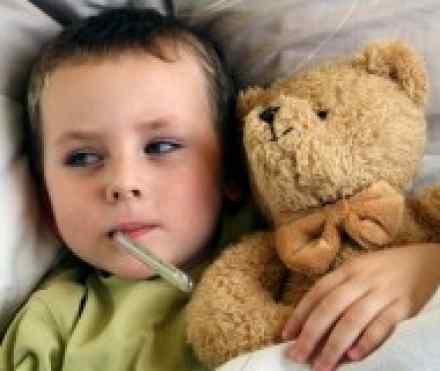
What is it?
- A common cold is a viral infection of the upper respiratory tract — your baby's nose and throat. Nasal congestion and a runny nose are the primary signs of common cold in babies. Babies are especially susceptible to the common cold, in part because they're often around other older children who don't always wash their hands. In fact, within the first two years of life, most babies have eight to 10 colds.
- Treatment for the common cold in babies involves taking steps to ease their symptoms, such as providing plenty of fluids and keeping the air moist. Very young infants must see a doctor at the first sign of the common cold, because they're at greater risk of complications such as croup or pneumonia.
Symptoms
The first indication of the common cold in a baby is often:
- A congested or runny nose
- Nasal discharge that may be clear at first, but then usually becomes thicker and turns shades of yellow or green
Other signs of a common cold may include:
- A low-grade fever of about 100 F (37.8 C)
- Sneezing
- Coughing
- Decreased appetite
- Irritability
- Difficulty sleeping
Causes
The common cold is an upper respiratory tract infection caused by one of more than 100 viruses. The rhinovirus and coronavirus are common culprits, and are highly contagious. Other viruses that may cause a cold include enteroviruses and coxsackieviruses.
Once your baby has been infected by a virus, he or she generally becomes immune to that specific virus. But because there are so many viruses that cause colds, your baby may have several colds a year and many throughout his or her lifetime.
A common cold virus enters your baby's body through his or her mouth or nose. Your baby may be infected with such a virus by:
- Air. When someone who is sick coughs, sneezes or talks, they may directly spread the virus to your baby.
- Direct contact. The common cold can also spread when someone who is sick touches his or her mouth or nose, then touches your baby's hand. Your baby can then become infected by touching his or her own eyes, nose or mouth.
- Contaminated surfaces. Some viruses can live on surfaces for two hours or longer. Your baby may also catch a virus by touching a contaminated surface, such as a toy.
Risk factors
A few factors put infants at higher risk of common colds.
- Immature immune systems. Infants are, by nature, at risk of common colds because they haven't yet been exposed to nor developed resistance to most of the viruses that cause them.
- Exposure to other children. They also tend to spend lots of time with other children, and children aren't always careful about washing their hands and covering their coughs and sneezes. So, if your baby is in child care or has an older, school-age brother or sister in the house, these may increase your baby's risk of catching a cold.
- Time of year. Both children and adults are more susceptible to colds in fall and winter, when the air is dry. Children are in school and most people are spending a lot of time indoors, which can make germs easier to spread to one another.
Complications
- Acute ear infection (otitis media). Between 5 and 15 percent of children who have the common cold develop an ear infection. Ear infections occur when bacteria or viruses infiltrate the space behind the eardrum.
- Wheezing. A cold can trigger wheezing, even if your child doesn't have asthma.
- Sinusitis. A common cold that doesn't resolve may lead to sinusitis — inflammation and infection of the sinuses.
- Other secondary infections. These include strep throat (streptococcal pharyngitis), pneumonia, bronchiolitis and croup. Such infections need to be evaluated by a doctor.
Treatments and drugs
Unfortunately, there's no cure for the common cold. Antibiotics don't work against cold viruses. The best you can do is take steps at home to try to make your baby more comfortable, such as suctioning mucus from his or her nose and keeping the air moist. Again, call the doctor early in the illness if your baby is younger than age 3 months.
Over-the-counter (OTC) medications should generally be avoided in infants. Fever-reducing medications may be safely used — carefully following dosing directions — if fever is making your child uncomfortable. Cough and cold medications are not safe for infants and young children.
Fever-reducing medications
OTC pain relievers such as paracetamol may help relieve discomfort associated with a fever. Don't give paracetamol to children under 2 months of age.
Ibuprofen also is OK, but only if your child is age 6 months or older.
Do not give these medications to your baby if he or she is dehydrated or vomiting continuously. And never give aspirin to someone younger than 18 years of age, because it may trigger a rare but potentially fatal condition called Reye's syndrome.
Cough and cold medications
The Irish medicine board strongly recommends against giving over-the-counter (OTC) cough and cold medicines to children younger than age 2. Their are numerous products available to children over 2 years old, for more information, ask your pharmacist.
Lifestyle remedies
Most of the time, you can treat an older baby's cold at home. Consider these suggestions:
- Offer plenty of fluids. Liquids are important to avoid dehydration. Encourage your baby to take in his or her normal amount of fluids. Extra fluids aren't necessary. If you're breast-feeding your baby, keep it up. Breast milk offers extra protection from cold-causing germs.
- Thin the mucus. Your baby's doctor may recommend saline nose drops to loosen thick nasal mucus. Look for these over-the-counter drops in your local pharmacy.
- Suction your baby's nose. Keep your baby's nasal passages clear with a rubber-bulb syringe. Squeeze the bulb syringe to expel the air. Then insert the tip of the bulb about 1/4 to 1/2 inch (0.64 to 1.27 centimeters) into your baby's nostril, pointing toward the back and side of the nose. Release the bulb, holding it in place while it suctions the mucus from your baby's nose. Remove the syringe from your baby's nostril, and empty the contents onto a tissue by squeezing the bulb rapidly while holding the tip down. Repeat as often as needed for each nostril. Clean the bulb syringe with soap and water.
- Moisten the air. Running a humidifier in your baby's room can help improve runny nose and nasal congestion symptoms. Aim the mist away from your baby's crib to keep the bedding from becoming damp. To prevent mold growth, change the water daily and follow the manufacturer's instructions for cleaning the unit. It might also help to sit with your baby in a steamy bathroom for a few minutes before bedtime.
Prevention
The common cold typically spreads through infected respiratory droplets coughed or sneezed into the air. The best defense? Common sense and plenty of soap and water.
- Keep your baby away from anyone who's sick, especially during the first few days of illness. If you have a newborn, don't allow visits from anyone who's sick. If possible, avoid public transportation and public gatherings with your newborn.
- Wash your hands before feeding or caring for your baby. When soap and water aren't available, use hand wipes or gels that contain germ-killing alcohol.
- Clean your baby's toys and pacifiers often.
- Teach everyone in the household to cough or sneeze into a tissue — and then toss it. If you can't reach a tissue in time, cough or sneeze into the crook of your arm.
Simple preventive measures can go a long way toward keeping the common cold at bay.
References:
https://www.nlm.nih.gov/medlineplus/commoncold.html
https://en.wikipedia.org/wiki/Common_cold
http://www.medicinenet.com/common_cold/article.htm
https://www.hse.ie/eng/health/az/C/Cold,-common/
http://www.commoncold.org/understand.htm






